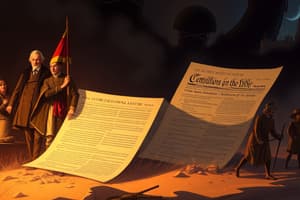Podcast
Questions and Answers
Which of the following was NOT a direct result of the advancements in technology in the early 1900s?
Which of the following was NOT a direct result of the advancements in technology in the early 1900s?
- The rise of new forms of leisure activities
- The increase in agricultural production (correct)
- The growth of suburbs and urban areas
- The spread of communication over long distances
Which of these was NOT considered a major leisure activity during the early 1900s?
Which of these was NOT considered a major leisure activity during the early 1900s?
- Attending baseball games
- Playing video games (correct)
- Going to amusement parks
- Traveling by train for pleasure
What was the primary goal of the Keating-Owen Act?
What was the primary goal of the Keating-Owen Act?
- To prohibit child labor in factories and mines (correct)
- To regulate the quality of meat products
- To ban the sale of mislabeled food and drugs
- To limit the power of corporations
Which amendment allowed for the direct election of U.S. senators?
Which amendment allowed for the direct election of U.S. senators?
Which progressive era legislation was directly aimed at protecting consumers from harmful products?
Which progressive era legislation was directly aimed at protecting consumers from harmful products?
What was the main purpose of the 18th Amendment?
What was the main purpose of the 18th Amendment?
Which of the following was a key characteristic of the Progressive Era?
Which of the following was a key characteristic of the Progressive Era?
What was the main goal of the Clayton Anti-trust Act?
What was the main goal of the Clayton Anti-trust Act?
What was a significant effect of the Platt Amendment on Cuba's independence?
What was a significant effect of the Platt Amendment on Cuba's independence?
Which foreign policy is associated with Theodore Roosevelt?
Which foreign policy is associated with Theodore Roosevelt?
Which of the following statements about Puerto Rico is accurate?
Which of the following statements about Puerto Rico is accurate?
What was the primary focus of William Howard Taft's foreign policy?
What was the primary focus of William Howard Taft's foreign policy?
How did the Roosevelt Corollary revise the original Monroe Doctrine?
How did the Roosevelt Corollary revise the original Monroe Doctrine?
What was one of Theodore Roosevelt's key beliefs as a modern president?
What was one of Theodore Roosevelt's key beliefs as a modern president?
What was the primary goal of Woodrow Wilson's New Freedom policy?
What was the primary goal of Woodrow Wilson's New Freedom policy?
How did Theodore Roosevelt view trusts?
How did Theodore Roosevelt view trusts?
What defined the difference between a conservationist and a preservationist?
What defined the difference between a conservationist and a preservationist?
What factor negatively affected the natural environment in the 19th century?
What factor negatively affected the natural environment in the 19th century?
What was a notable difference between William Howard Taft and Theodore Roosevelt's presidencies?
What was a notable difference between William Howard Taft and Theodore Roosevelt's presidencies?
What was unique about the 1912 presidential election?
What was unique about the 1912 presidential election?
Which group aimed for the immediate passage of a federal suffrage amendment?
Which group aimed for the immediate passage of a federal suffrage amendment?
What major factor fueled American imperialism in the late 19th century?
What major factor fueled American imperialism in the late 19th century?
How did the U.S. acquisition of Hawaii differ from its acquisition of Alaska?
How did the U.S. acquisition of Hawaii differ from its acquisition of Alaska?
What was a common view among those opposed to the annexation of Hawaii?
What was a common view among those opposed to the annexation of Hawaii?
What was one reason the U.S. declared war on Spain in 1898?
What was one reason the U.S. declared war on Spain in 1898?
What was yellow journalism primarily aimed at doing?
What was yellow journalism primarily aimed at doing?
What role did yellow journalism play in the Spanish-American War?
What role did yellow journalism play in the Spanish-American War?
Flashcards
Theodore Roosevelt
Theodore Roosevelt
Considered the first 'modern President' for expanding executive power and engaging with the public.
Bully Pulpit
Bully Pulpit
A tool for presidents to influence public opinion and legislation.
Square Deal
Square Deal
Roosevelt's policy aimed at fairness for workers, consumers, and businesses through regulation.
New Freedom
New Freedom
Signup and view all the flashcards
Trust Regulation
Trust Regulation
Signup and view all the flashcards
Conservation vs Preservation
Conservation vs Preservation
Signup and view all the flashcards
19th Century Environmental Impact
19th Century Environmental Impact
Signup and view all the flashcards
Taft and Roosevelt Similarities
Taft and Roosevelt Similarities
Signup and view all the flashcards
1912 Presidential Election
1912 Presidential Election
Signup and view all the flashcards
Alice Paul and Lucy Burns
Alice Paul and Lucy Burns
Signup and view all the flashcards
NAACP
NAACP
Signup and view all the flashcards
Causes of American Imperialism
Causes of American Imperialism
Signup and view all the flashcards
U.S. Acquisition of Hawaii
U.S. Acquisition of Hawaii
Signup and view all the flashcards
Yellow Journalism
Yellow Journalism
Signup and view all the flashcards
Reasons for Spanish-American War
Reasons for Spanish-American War
Signup and view all the flashcards
Roosevelt Corollary
Roosevelt Corollary
Signup and view all the flashcards
Big Stick Diplomacy
Big Stick Diplomacy
Signup and view all the flashcards
Platt Amendment
Platt Amendment
Signup and view all the flashcards
Status of Puerto Rico
Status of Puerto Rico
Signup and view all the flashcards
Electricity in daily life
Electricity in daily life
Signup and view all the flashcards
Impact of the automobile
Impact of the automobile
Signup and view all the flashcards
Rise of leisure activities
Rise of leisure activities
Signup and view all the flashcards
Meat Inspection Act
Meat Inspection Act
Signup and view all the flashcards
Pure Food and Drug Act
Pure Food and Drug Act
Signup and view all the flashcards
Keating-Owen Act
Keating-Owen Act
Signup and view all the flashcards
17th Amendment
17th Amendment
Signup and view all the flashcards
19th Amendment
19th Amendment
Signup and view all the flashcards
Study Notes
Turn of the Century Innovations
- New inventions simplified daily life, powering homes, workplaces, and appliances like refrigerators and washing machines.
- Automobiles provided easier transportation.
- Telephones improved long-distance communication.
- Radios offered entertainment and news.
Rise of Leisure Activities
- Industrialization created more free time, leading to increased leisure activities.
- Movies provided entertainment and influenced trends.
- Popular sports including baseball, football, and boxing became ingrained in American culture.
- Amusement parks offered family entertainment with rides and games.
- Dancing gained popularity, shaping cultural trends.
Progressive Era
- The government's role expanded, addressing social, political, and economic challenges of industrialization and urbanization.
- Regulations targeted businesses.
Progressive Era Solutions and Progressive Presidents – Specific Laws
- Meat Inspection Act: Established sanitary standards and federal inspections for meatpacking.
- Pure Food and Drug Act: Banned misbranded food and drugs, ensuring consumer safety.
- Keating-Owen Act: Prohibited child labor in factories and mines to protect children from exploitation.
- 17th Amendment: Allowed direct election of senators by the people, reducing political machine influence.
- 18th Amendment: Instituted Prohibition to address societal alcohol issues.
- 19th Amendment: Granted women the right to vote, addressing gender inequality.
- Clayton Antitrust Act: Reinforced antitrust laws, preventing monopolistic practices and addressing corporate abuse.
Theodore Roosevelt – First Modern President
- Expanded executive power, proactively addressing public issues.
- Used the "bully pulpit" for public engagement.
- Sought government intervention in social and economic issues (e.g., trust-busting, labor rights).
Theodore Roosevelt's and Woodrow Wilson's Progressive Policies
- Square Deal (Roosevelt): Focused on fairness by regulating businesses, breaking up monopolies, and supporting consumer and worker protection.
- Broke up monopolies.
- Passed the Meat Inspection Act.
- New Freedom (Wilson): Sought to restore competition and reduce corruption.
- Signed the Clayton Antitrust Act.
- Created the Federal Reserve.
Theodore Roosevelt’s View on Trusts
- Distressed by unfair practices and monopolies, he supported government regulation to differentiate harmful trusts from beneficial ones.
Conservationists vs. Preservationists
- Conservationists manage resources for sustainable use.
- Preservationists advocate for protecting nature from human interference.
Environmental Impact of Human Activity (19th Century)
- Industrialization, deforestation, and pollution were major environmental concerns.
- Clearing vast forest areas for agriculture.
- Industrial pollution from smoke and waste into air and water.
- Overhunting led to near extinction of species like the American bison.
Taft vs. Roosevelt
- Both supported progressive reforms, but Taft relied more on the courts, while Roosevelt was more aggressive in using executive power.
1912 Presidential Election
- The Republican party split, with Roosevelt forming the Progressive ("Bull Moose") Party.
- Democrat Woodrow Wilson won. Historians viewed progressivism as the true victor, as all major candidates supported progressive reforms.
Women's Suffrage Leaders and Organizations
- Alice Paul and Lucy Burns (National Women's Party): Immediate federal suffrage amendment, protested, and used hunger strikes.
- Elizabeth Cady Stanton and Susan B. Anthony (National American Woman Suffrage Association): Advocated for women's voting rights, state-by-state and federal amendment, used lobbying, speeches, and petitions.
- Mary Church Terrell and Ida B. Wells-Barnett (National Association of Colored Women): Focused on suffrage, civil rights, and social reforms for Black women, used activism and community mobilization.
Black American Civil Rights in the Progressive Era
- NAACP fought segregation through legal action.
- Booker T. Washington promoted vocational education.
- W.E.B. Du Bois demanded immediate civil rights.
- Ida B. Wells led anti-lynching campaigns.
American Imperialism Factors
- Economic Interests: Seeking new markets and resources to support industrial growth.
- Military Strength: Building a strong navy and overseas bases for global power.
- Cultural Superiority: Believing in the duty to spread democracy and Western values.
U.S. Investment in Hawaii
- Sugar industry.
U.S. Acquisition of Hawaii vs. Alaska
- Hawaii's annexation resulted from a forced takeover by American sugar planters, while Alaska was purchased peacefully.
Viewpoints on Annexation of Hawaii
- Supporters (U.S. business leaders) saw it for increased trade and military influence.
- Opponents (native Hawaiians and anti-imperialists) feared loss of sovereignty.
- Military perspective: strategic gain in the Pacific.
- Economic perspective: acquisition of valuable industries.
Reasons for the Spanish-American War
- Yellow Journalism: Exaggerated Spanish cruelty in Cuba.
- USS Maine Explosion: Increased tensions with Spain.
- Cuban Independence: Support for Cuba's fight for freedom.
- Economic Interests: U.S. investments in Cuba were at risk.
Yellow Journalism
- Sensationalized news to attract readers, arising from newspaper competition.
Roosevelt Corollary and Monroe Doctrine
- The Roosevelt Corollary expanded the Monroe Doctrine by asserting U.S. intervention in Latin America to ensure stability and prevent European intervention.
Presidential Foreign Policies
- Theodore Roosevelt (Big Stick Diplomacy): Used military power to back up peaceful negotiations.
- William Howard Taft (Dollar Diplomacy): Used economic investments to influence other countries.
- Woodrow Wilson (Missionary Diplomacy): Promoted spreading democracy and moral values abroad.
Spanish-American War Outcomes
- Cuba: Gained independence but remained under U.S. influence.
- Philippines: Became a U.S. colony.
- Puerto Rico: U.S. territory, eventually gaining citizenship.
- Guam: U.S. territory.
Puerto Rico and Guam Political Status
- Both are unincorporated U.S. territories, not states.
Puerto Rico and Guam Rights
- U.S. citizens, but lack voting rights in presidential or congressional elections.
Platt Amendment and Cuba’s Independence
- Limited Cuba's sovereignty by allowing U.S. intervention in Cuban affairs.
Studying That Suits You
Use AI to generate personalized quizzes and flashcards to suit your learning preferences.




